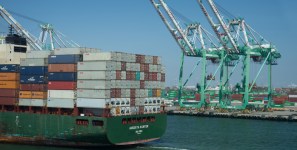Ports Face ‘Big Ships, Big Challenges’: White Paper
Long Beach, CA – The deployment of the latest generation of mega-containerships “presents physical, financial and operational challenges that must be met by port authorities across the country” according to the Port of Long Beach’s Acting Deputy Executive Director, Dr. Noel Hacegaba.
Even for ports that will not see the mega vessels call at their ports any time soon, the arrival of the larger ships is creating a cascading effect in which the ships being replaced by mega vessels are being deployed in the smaller trade lanes,” says Hacegaba in a new white paper, “Big Ships, Big Challenges.”
The average size of container ships, he says, has grown considerably in recent years and the trend is likely to continue for years to come.
“Although 18,000 TEU [20-foot equivalent unit] vessels are the largest in service currently, ships that carry more than 10,000 TEUs are still considered large and have limited options with regards to trade lanes and to ports that can accommodate them,” he writes.
Hacegaba said the industry is turning to the larger ships because they reduce operating costs for shipping operators, and they help meet regulatory requirements to decrease in potentially harmful emissions.
According to the white paper, ports around the country are spending $46 billion in capital improvements, including $4.5 billion invested at the Port of Long Beach. Shipping companies “are ordering larger ships to meet demand, while cutting the operational costs they would otherwise incur by sending cargo on multiple trips.”
As a result, ports of all sizes “are struggling to ready themselves to handle the larger vessels.”
Hacegaba states that regardless of a port’s size, they face a demand to handle a larger class of vessels. In the coming years it is projected that smaller vessels will be put out of services to make way for larger ones. But the largest ships will go to the biggest ports, while today’s larger ships will switch to smaller ports.
For the vessel operators, “the major investments in larger ships is straining their resources. So ocean carrier alliances and consolidations are also being forged as a result,” he says.
While this is not new to the maritime industry, Hacegaba points out that they are “providing financial uncertainty for port authorities.”
The newly aligned or consolidated vessel operators may move to different ports, while a smaller port may spend millions on fixing its infrastructure, and then lose a major tenant. In addition, smaller ports that don’t upgrade infrastructure because of their struggle for funding may face losing business as small-sized fleets are phased out.
The maritime industry “is ever evolving as technologies improve,” he concludes, with port authorities “playing a primary role” in educating both the industry and the public in potential changes.
“Ports must be built to handle larger ships and be prepared when shipping alliances do not go in their favor. As the maritime industry and how goods are moved change, so must ports if they are to be ready to handle the next generation of larger ships.”
0919/2014





Leave a Reply